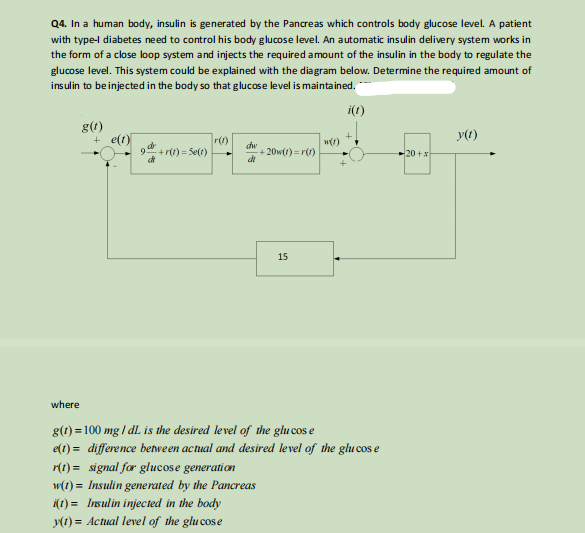human body, insulin is generated by the diabetes need to control his body glua of a close loop system and injects the re evel. This system could be explained with
human body, insulin is generated by the diabetes need to control his body glua of a close loop system and injects the re evel. This system could be explained with
Elements Of Electromagnetics
7th Edition
ISBN:9780190698614
Author:Sadiku, Matthew N. O.
Publisher:Sadiku, Matthew N. O.
ChapterMA: Math Assessment
Section: Chapter Questions
Problem 1.1MA
Related questions
Question
ques 4
plz provide handwritten step by step answer asap

Transcribed Image Text:Q4. In a human body, insulin is generated by the Pancreas which controls body glucose level. A patient
with type-l diabetes need to control his body glucose level. An automatic insulin delivery system works in
the form of a close loop system and injects the required amount of the insulin in the body to regulate the
glucose level. This system could be explained with the diagram below. Determine the required amount of
insulin to be injected in the body so that glucose level is maintained.
g(t)
+
d
+r(t) = 5e(t)
r(1)
dw
di
+20w(t)=r(t)
15
where
g(t) = 100 mg / dL is the desired level of the glucos e
e(t) =
r(t) =
signal for glucose generation
w(1) = Insulin generated by the Pancreas
i(t) = Insulin injected in the body
y(t) = Actual level of the glucose
w(1)
i(t)
+
difference between actual and desired level of the glucos e
20+x
y(1)
Expert Solution
This question has been solved!
Explore an expertly crafted, step-by-step solution for a thorough understanding of key concepts.
Step by step
Solved in 3 steps

Knowledge Booster
Learn more about
Need a deep-dive on the concept behind this application? Look no further. Learn more about this topic, mechanical-engineering and related others by exploring similar questions and additional content below.Recommended textbooks for you

Elements Of Electromagnetics
Mechanical Engineering
ISBN:
9780190698614
Author:
Sadiku, Matthew N. O.
Publisher:
Oxford University Press

Mechanics of Materials (10th Edition)
Mechanical Engineering
ISBN:
9780134319650
Author:
Russell C. Hibbeler
Publisher:
PEARSON

Thermodynamics: An Engineering Approach
Mechanical Engineering
ISBN:
9781259822674
Author:
Yunus A. Cengel Dr., Michael A. Boles
Publisher:
McGraw-Hill Education

Elements Of Electromagnetics
Mechanical Engineering
ISBN:
9780190698614
Author:
Sadiku, Matthew N. O.
Publisher:
Oxford University Press

Mechanics of Materials (10th Edition)
Mechanical Engineering
ISBN:
9780134319650
Author:
Russell C. Hibbeler
Publisher:
PEARSON

Thermodynamics: An Engineering Approach
Mechanical Engineering
ISBN:
9781259822674
Author:
Yunus A. Cengel Dr., Michael A. Boles
Publisher:
McGraw-Hill Education

Control Systems Engineering
Mechanical Engineering
ISBN:
9781118170519
Author:
Norman S. Nise
Publisher:
WILEY

Mechanics of Materials (MindTap Course List)
Mechanical Engineering
ISBN:
9781337093347
Author:
Barry J. Goodno, James M. Gere
Publisher:
Cengage Learning

Engineering Mechanics: Statics
Mechanical Engineering
ISBN:
9781118807330
Author:
James L. Meriam, L. G. Kraige, J. N. Bolton
Publisher:
WILEY